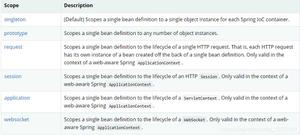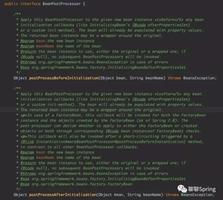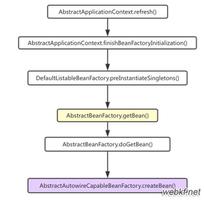Spring定义bean的三种方式和自动注入
本文内容纲要:
- 一、定义bean的三种途径:- 二、Spring的自动注入
- 三、如何进行选择?
一、定义bean的三种途径:
- 首先编写Student和Teacher两个类
public class Student {private String name;
private Teacher teacher;
public String getName() {
return name;
}
public void setName(String name) {
this.name = name;
}
public Teacher getTeacher() {
return teacher;
}
public void setTeacher(Teacher teacher) {
this.teacher = teacher;
}
}
public class Teacher {
private String name;
public String getName() {
return name;
}
public void setName(String name) {
this.name = name;
}
}
方法一:基于XML的bean定义(需要提供setter方法)
<?xml version="1.0" encoding="UTF-8"?><beans xmlns="http://www.springframework.org/schema/beans"
xmlns:xsi="http://www.w3.org/2001/XMLSchema-instance"
xsi:schemaLocation="http://www.springframework.org/schema/beans http://www.springframework.org/schema/beans/spring-beans.xsd">
<bean id="student" class="test.Student">
<property name="name" value="张三"/>
<property name="teacher" ref="teacher"/>
</bean>
<bean id="teacher" class="test.Teacher">
<property name="name" value="李四"/>
</bean>
</beans>
[java] view plain copy
public class Main {
public static void main(String args[]){
FileSystemXmlApplicationContext context=new FileSystemXmlApplicationContext("applicationContext.xml的绝对路径");
Student student= (Student) context.getBean("student");
Teacher teacher= (Teacher) context.getBean("teacher");
System.out.println("学生的姓名:"+student.getName()+"。老师是"+student.getTeacher().getName());
System.out.println("老师的姓名:"+teacher.getName());
}
}
- 方法二:基于注解的bean定义(不需要提供setter方法)
Spring为此提供了四个注解,这些注解的作用与上面的XML定义bean效果一致,在于将组件交给Spring容器管理。组件的名称默认是类名(首字母变小写),也可以自己修改:
@Component:当对组件的层次难以定位的时候使用这个注解
@Controller:表示控制层的组件
@Service:表示业务逻辑层的组件
@Repository:表示数据访问层的组件
使用这些注解的时候还有一个地方需要注意,就是需要在applicationContext.xml中声明contex:component-scan...一项,指明Spring容器扫描组件的包目录。
@Component("teacher")public class Teacher {
@Value("李四")
private String name;
public String getName() {
return name;
}
}
[java] view plain copy
@Component("student")
public class Student {
@Value("张三")
private String name;
@Resource
private Teacher teacher;
public String getName() {
return name;
}
public Teacher getTeacher() {
return teacher;
}
}
[html] view plain copy
<?xml version="1.0" encoding="UTF-8"?>
<beans xmlns="http://www.springframework.org/schema/beans"
xmlns:xsi="http://www.w3.org/2001/XMLSchema-instance"
xmlns:context="http://www.springframework.org/schema/context"
xsi:schemaLocation="http://www.springframework.org/schema/beans
http://www.springframework.org/schema/beans/spring-beans.xsd
http://www.springframework.org/schema/context
http://www.springframework.org/schema/context/spring-context.xsd">
<!--扫描组件的包目录-->
<context:component-scan base-package="test"/>
</beans>
[java] view plain copy
public class Main {
public static void main(String args[]){
FileSystemXmlApplicationContext context=new FileSystemXmlApplicationContext("applicationContext.xml的绝对路径");
Student student= (Student) context.getBean("student");
Teacher teacher= (Teacher) context.getBean("teacher");
System.out.println("学生的姓名:"+student.getName()+"。老师是"+student.getTeacher().getName());
System.out.println("老师的姓名:"+teacher.getName());
}
}
方法三:基于Java类的bean定义(需要提供setter方法)
@Configurationpublic class BeansConfiguration {
@Bean
public Student student(){
Student student=new Student();
student.setName("张三");
student.setTeacher(teacher());
return student;
}
@Bean
public Teacher teacher(){
Teacher teacher=new Teacher();
teacher.setName("李四");
return teacher;
}
}
[java] view plain copy
public class Main {
public static void main(String args[]){
AnnotationConfigApplicationContext context=new AnnotationConfigApplicationContext(BeansConfiguration.class);
Student student= (Student) context.getBean("student");
Teacher teacher= (Teacher) context.getBean("teacher");
System.out.println("学生的姓名:"+student.getName()+"。老师是"+student.getTeacher().getName());
System.out.println("老师的姓名:"+teacher.getName());
}
}
二、Spring的自动注入
- Spring提供了五种自动装配的类型
no:顾名思义, 显式指明不使用Spring的自动装配功能
byName:根据属性和组件的名称匹配关系来实现bean的自动装配
byType:根据属性和组件的类型匹配关系来实现bean的自动装配,有多个适合类型的对象时装配失败
constructor:与byType类似是根据类型进行自动装配,但是要求待装配的bean有相应的构造函数
autodetect:利用Spring的自省机制判断使用byType或是constructor装配
基于XML的自动装配
<bean id="student" class="test.Student" autowire="byName"><property name="name" value="张三"/>
</bean>
<bean id="teacher" class="test.Teacher">
<property name="name" value="李四"/>
</bean>
这里我并没有显式为Student对象注入Teacher属性,而是使用autowired="byName"代替,这样一来Spring会帮我们处理这些细节,将名字是teacher的组件注入到Student对象中。
- 基于注解的自动装配
其实上面已经应用过了,这里再提一下@Resource和@Autowired的区别。@Resource默认是使用byName进行装配,@Autowired默认使用byType进行装配。
@Component("teacher")public class Teacher {
@Value("李四")
private String name;
public String getName() {
return name;
}
public void setName(String name) {
this.name = name;
}
}
@Component("student")
public class Student {
@Value("张三")
private String name;
@Resource
private Teacher teacher;
public String getName() {
return name;
}
public void setName(String name) {
this.name = name;
}
public Teacher getTeacher() {
return teacher;
}
public void setTeacher(Teacher teacher) {
this.teacher = teacher;
}
}
三、如何进行选择?
<property name="driverClassName" value="com.mysql.jdbc.Driver"/><property name="url" value="jdbc:mysql://localhost:3306/study"/>
<property name="username" value="账号"/>
<property name="password" value="密码"/>
</bean>
自动装配:一般我使用基于注解的自动装配。同样也是为了减少XML配置文件的“篇幅”。
本文内容总结:一、定义bean的三种途径:,二、Spring的自动注入,三、如何进行选择?,
原文链接:https://www.cnblogs.com/yimian/p/8286558.html
以上是 Spring定义bean的三种方式和自动注入 的全部内容, 来源链接: utcz.com/z/296094.html








